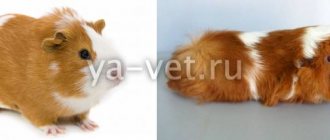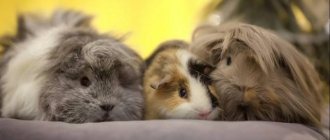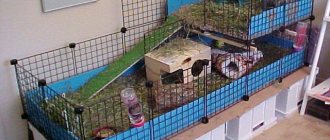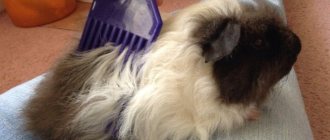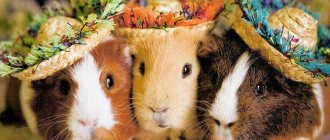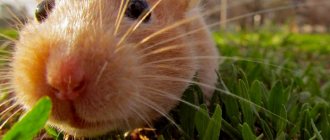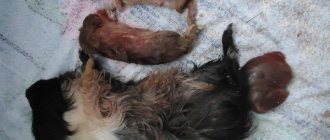A runny nose in a guinea pig, like a cold, usually occurs due to the fault of the animal's owner. The most common cause of colds in pets is non-compliance with the rules of care and maintenance. If your pig shows characteristic signs of a cold (runny nose, cough, sneezing, inactivity and refusal to eat), you need to take immediate action. You should not hesitate in the hope that the animal’s body will defeat the disease on its own - this will not happen. If left to its own devices, the disease will kill the pig in a short time. A cold is dangerous for an animal - it can quickly develop into rhinitis, bronchitis or pneumonia, so if you notice signs of a cold in your pig, you need to start treatment immediately.
What can cause a guinea pig to catch a cold?
By nature, animals have a strong immune system, which loses its strength if the pig is not kept properly and the requirements for caring for it are not met. The main reason why a guinea pig gets a cold is hypothermia. This condition occurs if:
- the temperature of the pet’s environment is less than +18° C;
- the rodent is in a draft or near the air conditioner;
- after bathing, the pet’s coat is not wiped dry enough;
- water procedures are too frequent.
These are the most common causes of hypothermia. They also include infection from the owner - a pig can catch a cold from a sick person. Therefore, if there is a cold, the owner of a rodent should reduce communication with the pet to a minimum until it recovers.
An incorrectly formulated diet significantly contributes to the occurrence and development of the disease in a guinea pig. Especially if the deviation from the recommended menu concerns vitamins (mainly C) - the less the pet’s body receives these elements, the higher the risk of a cold. The lack of fresh fruits, vegetables and herbs in your pet’s diet greatly increases the likelihood of illness.
Possible causes of a cold in an animal
Guinea pigs have a good immune system. But it largely depends on the quality of food that this animal consumes. The food must be of good quality and contain all the vitamin complexes necessary for the animal (C, A, and so on).
Possible causes of colds in this rodent may be:
- Hypothermia. The air temperature in the room where this animal is kept should be more than +18ºС.
- Drafts. The cage must be located in a quiet place where there are no drafts and the air conditioner is not blowing.
- Bathing. After this procedure, the wool should be thoroughly wiped. You can even dry it a little with a hairdryer.
- Litter. Poor quality filler, as well as extremely rare replacement. Wet litter should be removed as needed.
Did you know? Guinea pigs became pets about 5 thousand years ago in South America. They were domesticated by tribes living in the Andes.
How to tell if your guinea pig has a cold
The animal's illness affects its behavior. Sneezing, coughing and runny nose are the main symptoms of a cold, but they are not the only ones. Sick rodent:
- Often rubs the muzzle (especially the nose);
- refuses food;
- snorts;
- breathes heavily (sometimes wheezing can be heard);
- looks weak and lethargic;
- remains motionless for a long time (most often lies, but can also sit).
The eyes of a pet with a cold turn red and the eyelids swell. In addition to a runny nose, there may be discharge from the eyes (tears or pus). The fur coat becomes dull and appears disheveled. The animal's body temperature rises. A sick pet often prefers to be in the far corner of his house and rejects all attempts by the owner to pull him out of the found “shelter”.
If these signs are detected, you should take the rodent to a veterinarian as soon as possible. Delay in seeking medical help will lead to the death of your pet.
If your pig is breathing heavily and wheezing
A cough does not always indicate diseases of the bronchopulmonary system. Sometimes this indicates cardiac pathology.
The animal needs quick help and advice from a specialist.
Symptoms of heart failure:
- The pig gasps for air;
- breathing heavily;
- periodic coughing;
- shortness of breath when moving;
- immobility develops;
- lethargy and apathy;
- paws are cool;
- fingers turn blue;
- coordination of movements is impaired;
- convulsions.
To stop heart and asthmatic attacks, you need to immediately drop 2 drops of Corvalol into the mouth and then let the animal smell cotton wool soaked in aroma oil. The animal is given an injection that includes aminophylline, dexamethasone, and furosemide.
They treat heart failure for a long time, maintaining vitality.
Heart drops are administered to the rodent using an insulin syringe with the needle removed.
An animal suffering from heart failure needs proper nutrition and good living conditions.
At the first symptom of illness, treatment should begin. The speed of recovery depends on the speed of contacting a veterinarian.
Guinea pig snot
A runny nose in a rodent is a symptom not only of a cold, but also of bronchitis, rhinitis, pneumonia, and allergies.
With allergies, a guinea pig's snot is liquid and transparent. In addition, the animal’s eyes usually run red and runny, hair falls out, and there are rashes on the skin. The following may act as an allergen:
- feed;
- filler;
- hay;
- houseplants;
- dust;
- chemicals;
- pungent odors, etc.
The basis of treatment is not only taking the medications prescribed by the veterinarian, but also eliminating the causative agent of the allergy.
In any case, if your pet has a runny nose, you should immediately consult a doctor.
Sneezing caused by allergies
There can be many reasons why a guinea pig sneezes. Most often, breeders encounter allergies, one of the symptoms of which is frequent sneezing. Allergies in animals can be caused by:
- New toilet filler,
- New or too dusty litter,
- Hay (too dusty or not fresh),
- Industrial feeds,
- stale water,
- Too dusty air in the room.
Allergies can be detected by routine examination.
If the animal looks normal, is active, does not refuse to eat and drink, but a rash appears on the skin, the guinea pig sneezes and itches, and the mucous membrane of the eyes turns red, then the diagnosis is accurate even without visiting a veterinarian.
Prevention and treatment of allergies
Allergies are treated by eliminating the allergen. If there has been a change in food, you should review the guinea pig’s diet again, check the hay, bedding, and the cleanliness of the feeders and drinkers. It is better to feed pre-soaked hay for several days, and also check dry food for excess dust. The room where the cage is located must be well ventilated. The most common cause of allergies is bedding made from sawdust or cotton filling, so when purchasing, you should make sure that the manufacturer is clean and reliable. Sawdust has a number of advantages: it is light, soft, cheap and environmentally friendly, and absorbs odors and moisture.
However, low-quality sawdust can be a source of allergies, fungus, and even skin parasites.
Improper storage of sawdust leads to the appearance of mold and fungal growths, which immediately negatively affects the health of the guinea pig. Cotton filler bedding consists of cotton fibers and seeds with the addition of a small amount of sawdust. If storage conditions are violated, mites, fungus, and mold may form in the fibers. This will provoke not only allergies, but also much more serious diseases. If a guinea pig has an allergy to some type of food or bedding, it is not recommended to buy products from this company in the future and try to find a good and safe replacement. If removal of the allergen does not produce results, it is worth using antihistamines. Veterinarians allow the use of children's anti-allergenic suspensions for guinea pigs. The dose of the drug is calculated based on the weight of the pig. The medicine is given once a day for four to five days.
Why does a guinea pig cough?
There are many reasons why an animal may cough. Coughing is a protective reflex that clears the respiratory system of irritants. The causative agents of cough are both infections and foreign objects that accidentally enter the respiratory tract. As for diseases, cough most often accompanies:
- cold;
- bronchitis;
- pneumonia;
- pulmonary edema;
- dental diseases;
- parasite infestation;
- heart problems.
If your pet coughs, you should immediately go to the doctor without wasting time trying to figure out the cause of the cough on your own. The same rule applies to sneezing, wheezing and other abnormalities in the pet’s well-being. The sooner the animal is under the control of professionals, the greater the chances of soon seeing it healthy and vigorous.
Pneumonia
Pneumonia, like bronchitis, is a serious and dangerous disease. A distinctive symptom is sputum production with a cough, as well as wheezing in the lungs. Snoring and whistling sounds are heard during sleep.
Timely contact with a veterinarian increases the chances of a quick and successful recovery. When the first symptoms of pneumonia appear, the pig is given Sulfadimezin and the nose is washed with Streptocide. If there is improvement after self-treatment, this is not a reason to refuse to visit a doctor. Often the symptoms stop temporarily, only to return later with complications.
What to do if your guinea pig has bronchitis
An advanced cold or rhinitis often transforms into bronchitis. In addition to hypothermia, bronchitis can be caused by:
- finding your pet in a dusty or smoky environment;
- parasite infection;
- entry of pathogenic microbes into the animal’s body.
The main symptom of bronchitis is a severe dry cough. The pet has difficulty breathing. He appears exhausted and depressed and does not touch food or drink. There are purulent leaks from the nose and eyes.
Under no circumstances should you delay starting treatment for your pet. Bronchitis is extremely dangerous for a small pet. If not treated promptly, this disease will lead to a heart attack or exhaustion, resulting in the death of the animal.
Pneumonia in a guinea pig
Pulmonary inflammation (pneumonia) can be an infectious disease or a consequence of advanced diseases, such as:
- cold;
- rhinitis;
- pulmonary edema;
- bronchitis.
Pneumonia most often occurs in young animals or those with weakened immune systems. Pneumonia usually occurs in spring and autumn. The key causes of this disease are:
- finding the animal in a draft;
- keeping your pet (even for a short time) in cold or damp conditions;
- changes in humidity or temperature in the environment surrounding the pig.
In many ways, pneumonia is caused by improperly formed nutrition of the animal. Pneumonia in mumps can be both acute and chronic. Both forms are extremely dangerous. Acute is dangerous because of its swiftness. In just a few days, the pet goes through all stages of the disease - fever, exhaustion, intoxication - and eventually dies. Starting treatment in the final stages will no longer give results and will not save the animal. Therefore, it is very important to start therapy at the first signs of the disease.
The chronic form is dangerous due to its inexpressiveness. Proceeding with subtle symptoms, it greatly shortens the animal’s lifespan. It has a detrimental effect on the immune system, as a result of which the pet begins to constantly get sick with one thing or another.
How to recognize inflammation
Pneumonia in a pig is recognized by the behavior of the animal. It's bad if the pet:
- refuses food and water;
- coughs (the cough can be either dry or wet);
- sneezes;
- sniffles and grunts;
- wheezes when breathing (wheezing is often accompanied by gurgling or whistling);
- loses activity, becomes lethargic and depressed;
- ruffled, sits or lies for a long time without moving;
- does not respond to either the owner or the treat;
- sleeps a lot.
Characteristic features also include:
- discharge from the eyes and nose;
- formation of crusts on the nose;
- redness and swelling of the eyes and eyelids;
- gluing of the palpebral fissure with accumulated pus;
- deterioration in the appearance and quality of fur.
Mumps should be treated at the first symptoms of the disease and only under the guidance of a veterinarian. It is important to defeat the disease completely. There are often cases when an improvement in the animal’s condition is replaced by a relapse with subsequent complications and death of the rodent.
Consult, cough
Consult, cough ¶
From: Danary - January 17, 2011 8:42
AM The pig coughs periodically, if you can call it that, as if she was choking and trying to burp. This happens while eating. He doesn't cough when he sleeps. The appetite is good, the pig is cheerful. What could it be?
Consult, cough ¶
From: Yma - January 17, 2011 11:20 am
The pig coughs periodically, if you can call it that, as if she was choking and trying to burp. This happens while eating. He doesn't cough when he sleeps. The appetite is good, the pig is cheerful. What could it be? You need to check your teeth. Perhaps something is stuck between the crowns and therefore interferes with chewing and swallowing normally.
Consult, cough ¶
From: melonie - January 18, 2011 11:36 pm
I've had a similar situation since the fall. The pig seems to be choking on something, making sounds similar to coughing. When it all started, we thought she had a cold. They treated it and everything went away, but a month later this strange cough came back. But, it’s already very rare. He coughs, sometimes once a day, sometimes once a week, and that’s it. Now, I haven't heard anything for a month. His teeth are normal, he eats well, his appetite is excellent. We thought about teeth, and a reaction to smoke, and a cold, but thank God!! nothing is confirmed!! We decided that when it gets warmer, we’ll take pictures and go to the reception with the Vysokikhs.
Article on the topic: Vitamins for guinea pigs: which ones are needed and how to give them
Consult, cough ¶
From: Danary - January 19, 2011 12:24 pm
She examined the entire oral cavity and teeth. I didn't see anything unusual. Yesterday I didn’t cough anymore. I'll watch.
Consult, cough ¶
From: della - January 19, 2011 2:48 pm
Mine has the same thing... I coughed a lot, as if I had a cold, I gave Biseptol, it seemed to go away, my weight returned to normal. when I stopped giving Biseptol (I gave it for 7-9 days) - my weight dropped again (by 70 grams) and again I sometimes cough ((((
Consult, cough ¶
From: kooksy - January 19, 2011 4:19 pm
Observe exactly when they cough) Sometimes, when they drink too hard from the water bowl, this happens.
Consult, cough ¶
From: della - January 19, 2011 4:35 pm
mine is definitely not from the drinking bowl. by itself and sometimes happens when I tilt it (when landing in a dune)
Consult, cough ¶
From: melonie - January 19, 2011 10:34 pm
It seems to me that you don’t need Biseptol and other strong drugs right away!! I brewed: breast tea with bearberry root. I bought the sachets at a regular pharmacy. It was sweetish and the pig drank it with pleasure. In the drinking bowl - a spoonful of rosehip syrup to boost immunity. We didn't lose weight.
Consult, cough ¶
From: della - January 20, 2011 12:45 pm
What is the name of the syrup that you added to the drinker?
Consult, cough ¶
From: Tishka - February 10, 2011 10:35
Girls, my pig has the same bullshit - she coughs periodically. At first they thought that she had caught a cold, and the vet almost healed it to death. Another vet suggested that the wheezing may be due to some structural feature of the nasopharynx. I can see for myself that this cough is not from a cold. I learned not to panic. When he wheezes, of course, his soul is restless. But the pig coughs - and everything is fine again for a while. Sometimes I take it in my hands and twirl it so that it clears its throat faster.
Article on the topic: Sebaceous gland in guinea pigs: where to find and how to clean
Consult, cough ¶
From: Aniri1 - February 10, 2011 10:40
I’ll risk expressing my thoughts on this matter: if a vet who understands mumps said something about the peculiarities of the nasopharynx, then this is possible and is taking place. After all, people also have deviated septums in the nose, for example, hence snoring.
Are you sure you have a cough? They just seem to sneeze. And they can sneeze from the dust of sawdust and hay.
Consult, cough ¶
From: Tishka - February 11, 2011 0:39
That's right, he's coughing. Sneezes differently. The vet doesn't know anything about pigs. This was an assumption. But I was convinced that it was not a cold. The first time Nyushka coughed was about a week and a half after she moved in with us. I panicked. I started treatment with Biseptol, because... The vet said it was pneumonia. During treatment, Nyushka did not cough. After finishing the course of antibiotics, three days later she coughed again. I'm shocked. To the vet. She injected me with an antibiotic that was poisonous to pigs (I didn’t know this at the time) and gave it to me for five more times. Okay, I've been enlightened here. She didn't prick anymore. In short, Nyushka survived, but she did not stop wheezing and coughing from time to time. Another vet examined and listened to him during the period of wheezing and said that everything was fine on the part of the lungs. There was no runny nose. This is how we live - periodically clearing our throat.
Treatment
How and with what to treat the unfortunate furry patient is determined only by the doctor - self-medication is prohibited. The owner of a guinea pig should know what to do before visiting a veterinarian. If the pet refuses to eat, it is fed food crushed into a paste through a syringe (without a needle), in small portions 5-6 times a day.
If your pig has a stuffy nose, it is important to clear it as soon as possible so that the animal can breathe and the infection does not spread to the lungs and bronchi. To clean a rodent's nose, you need to do the following:
- Place the animal on its back.
- While holding your pet in a lying position, drop chlorhexidine in the form of a warm solution into his nose. Dosage – one drop in each nostril.
- Using a gauze pad, wipe your guinea pig's nose dry.
- Place Derinat drops for children into both nostrils of the animal.
- Place the pet on its paws.
This procedure is designed to clear the pig's nose of excess mucus and pathogenic infection through reflex sneezing. The procedure is carried out three times a day before visiting the veterinarian. If the nasal discharge contains pus, the procedure should be completed twice a day by gently blowing streptocide powder into the nose. These measures do not replace the need for a visit to the doctor - only a specialist can prescribe full therapy.
A guinea pig should be treated for a cold at the first sign of illness. You should not try to cure the animal on your own - self-medication will only complicate the situation. To prevent the development of serious diseases, you should immediately contact a veterinarian. This will help restore your pet’s health and return him to his normal life.
How to treat your pet for a cold
A sick animal should not be treated independently, but rather shown to a veterinarian. But some actions can be performed before visiting a veterinarian. A stuffy nose should be rinsed. To do this, the animal must be placed on its back and a drop of chlorhexidine and Derinat children's drops should be placed into the nostrils to increase immunity.
Also find out where the name "guinea pig" comes from.
After instillation, wipe the nose with a piece of bandage or gauze, and put the pig on its paws. This procedure is done three times a day, preferably with a partner. After it, the animal begins to sneeze, and the nasal cavity is cleared. Then it is recommended to blow Streptocide powder into the nostrils.
If inflammation of the eyes is observed, they are washed with boiled water and instilled with anti-inflammatory drops (for example, “Tsiprovet”). The sick animal is prescribed vitamins, medicinal decoctions and anti-inflammatory drugs. Usually these are sulfonamides. Treatment largely depends on how advanced the infection is.

